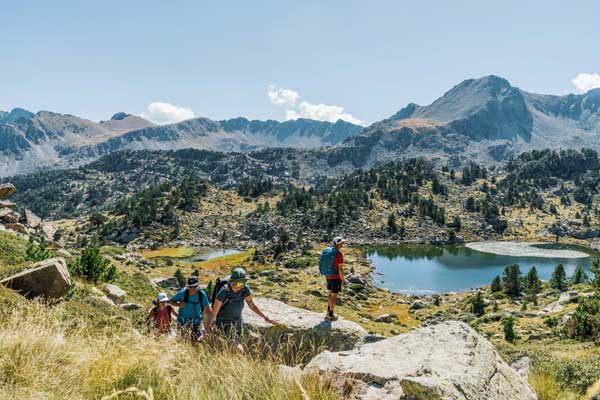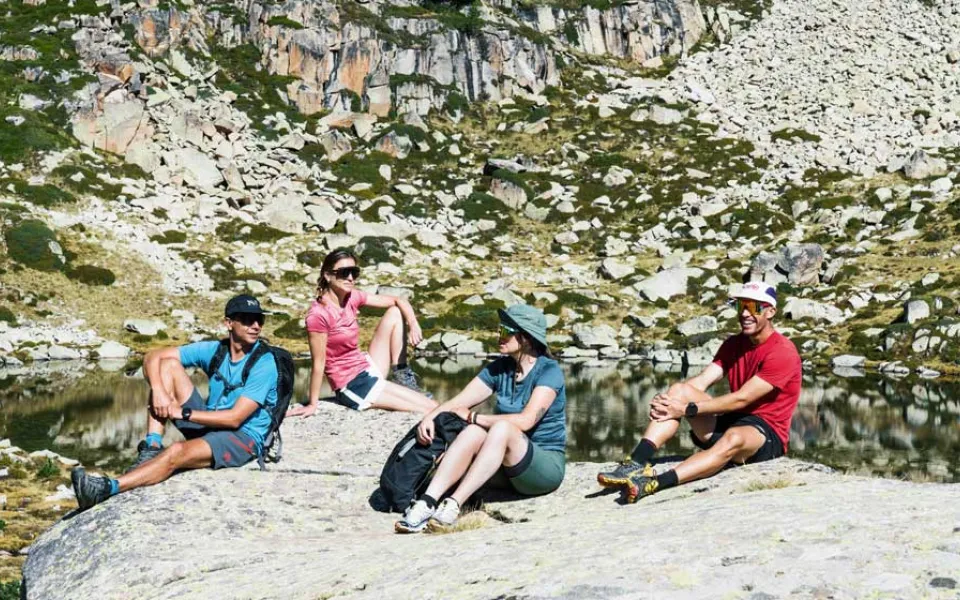 If you visit Andorra and the weather is nice, which it often is in the principality, you might think about exploring one of the best walks and day trails in Andorra. If you do, then you’ll want to know how to prepare for hiking in the Pyrenees and how to pack a trekking backpack. In this guide to how to pack a bag for hiking, that’s exactly what we’re about to discuss.
If you visit Andorra and the weather is nice, which it often is in the principality, you might think about exploring one of the best walks and day trails in Andorra. If you do, then you’ll want to know how to prepare for hiking in the Pyrenees and how to pack a trekking backpack. In this guide to how to pack a bag for hiking, that’s exactly what we’re about to discuss.
Before you start packing: Essential gear for hikers
Before you even begin to put items and pieces of equipment into your backpack, you want to make sure you have everything you need.
The right backpack: Choosing the perfect fit
First things first, you’ll want to have the right backpack. What makes for a good hiking backpack? Well, first of all you should consider the materials and make sure the bag is waterproof if it needs to be waterproof, and light if it needs to be light. Secondly, spend time finding a backpack which fits perfectly. It really is worth trying it on first, which means shopping online isn’t always the ideal route when it comes to something as important as a backpack.
Ten essentials for safe and enjoyable hiking
What should you pack in your bag for hiking? Well, it’ll depend on the trip, and we’ll get on to that later, but 10 essential items for safe and enjoyable hiking include: first-aid kit, water, food, torch, map, compass, toilet paper, sunscreen, extra layers and spare socks.
Additional gear for specific conditions (weather, terrain)
Depending on the specific conditions of your hike, which could mean the weather or the type of terrain you’ll be covering, you might want to consider packing additional items. If, for example, you expect cold and rainy conditions, consider taking even more spare clothes. If, for another example, the terrain could be rocky and challenging, you might want to prepare for blisters.
The packing system: Organising your backpack for efficiency
In what order should I pack my backpack? That’s a common question and one that has a few different answers, depending on who you ask and depending on what kind of trip you’re planning. But, there are a few standard practices for how to pack a hiking backpack, so let’s go through them.
The three zones: Bottom, middle and top
Imagine your backpack is split into three different zones, namely the bottom, the middle and the top. Each of these zones has a specific kind of item which it should store. The bottom should have the pieces of equipment you’re least likely to need. The middle should also have infrequently-used items and your heavier items, to ensure good weight distribution. Then, the top should be reserved for your essentials and frequently used items.
Accessibility: What to pack where
Imagine you stop for an emergency and need your first-aid kit. Then, imagine you realise you packed it at the very bottom of the backpack. What will follow is a frantic scene in which you pull everything out as you try to dig to the bottom of your bag in search of that one item. This is why accessibility is important and why it’s worth thinking about what you’re most likely to need.
Weight distribution: Balancing your load
Even if you’re only going on a short summer activity in Andorra, you’ll probably still be carrying your backpack for a few hours. Achieving optimal weight distribution is, therefore, important, to avoid damaging your back or shoulders.
One key tip for how to pack a bag for hiking in a way that makes it as comfortable as possible on your back is to place the heaviest items in the middle of the backpack and on the back side, the side that will be in contact with your back. With this system, your back has the heaviest items closest to it, requiring less strain.
Step-by-step guide: Packing your backpack like a pro
Let’s put all of this advice about how to pack a bag for hiking into a handy step-by-step guide. Here, then, is a six-step guide for how to pack a trekking backpack:
Step 1: Lay out your gear
Make sure you can see all of the items you plan to take before putting anything inside. Even take a photo of all the gear, so you can remind yourself of what you packed in case you panic halfway through the hike that you’ve forgotten something.
Step 2: Pack the bottom zone (sleeping gear)
If you’re staying overnight and have sleeping gear with you, that should go near the bottom because it’s the last gear you’ll need. Therefore, it should go into the bag first.
Step 3: Pack the middle zone (heavy items)
Weight distribution is a key part of how to pack a trekking backpack, so place the heavier items, as long as they are non-essential, in the middle part.
Step 4: Pack the top zone (essentials and frequently used items)
Next up is the top zone, which is where your essentials and your frequently used items should go. A first-aid kit may not be frequently used, and you hope it stays that way, but it’s a must for this to be near the top.
Step 5: Utilise external pockets and straps
If your backpack has external pockets and other sections capable of storing little items, make the most of this. Some essentials or frequently used items can even go in these external pockets, so long as they fit well.
Step 6: Final check: Weight, balance and accessibility
The final step in how to pack a backpack for hiking is to check how the bag feels, in terms of weight and balance. Try it on and imagine carrying it for several hours. Also have a quick trial run of searching for something, to understand if your important items are really as accessible as you think they are.
Packing tips and tricks for specific types of hikes
While all of the above advice is relevant and useful and worth noting down, it’s true that how to prepare for hiking can differ depending on what kind of hike you’re going on. Will you be away for a few hours or a few days, for example? Let’s, therefore, break down some packing tips and tricks for specific types of hikes.
Day hikes: Lightweight and essentials-focused
If you’re only planning to be away for a day, you should still keep in mind that your return could be delayed and that the walk might last longer than you thought. Still, a day hike means you can afford to bring a little bit less and you can probably take a more lightweight approach to which clothing you bring and how many spare layers you carry. In any case, essentials remain a must.
Overnight hikes: Balancing comfort and weight
The biggest difference with overnight hikes vs day hikes is that you’ll have to bring your tent and sleeping bag with you. These are big items and also heavy items, so this means it’s important to really think about and nail your weight distribution. You need to find a balance, while also keeping in mind that these items cannot afford to get wet, so they probably do need to go inside the bag.
Multi-day hikes: Planning for resupply and gear changes
The difference from an overnight hike to a multi-day hike isn’t so great. You’ll require slightly more clothes, but you’ll also probably be planning a stop at some point to freshen up and restock your gear. The key here is to plan, and to invest the time in how to prepare for hiking beforehand, not during.
Common packing mistakes to avoid
Now that we’ve gone through what you should do when packing a backpack for hiking, let’s also highlight a few common backpack packing mistakes, so that you can avoid them.
Overpacking: The burden of unnecessary weight
The biggest question mark in terms of how to pack a bag for hiking is always going to be related to underpacking vs overpacking. You don’t want to be stuck in a forest and realise you’ve forgotten an essential item. At the same time, you simply cannot bring every single thing you might possibly need with you. Ultimately, understanding what you do need and what you probably don’t need comes with experience, and over time you’ll learn how to avoid the burden of unnecessary weight.
Poor weight distribution: Back strain and imbalance
Even if you’ve reduced the overall weight that you’re going to carry in your backpack, poor weight distribution can be just as problematic. If you pack your bag in a way which puts too much pressure on one area over another, you could have an awkward walk and even suffer longer-term effects.
Inaccessible items: Frustration on the trail
Finally, the number one rule of how to pack a backpack for hiking is to make sure that the items you need are near the top and the ones you don’t need are near the bottom. The most frustrating moment on a hike can be the realisation that you packed an important item near the bottom of your bag. Pack with thought and with foresight, and you’ll be able to enjoy a pleasant and fruitful hike!
